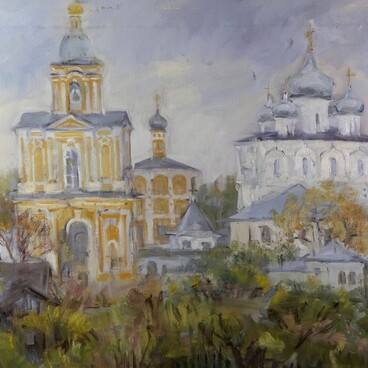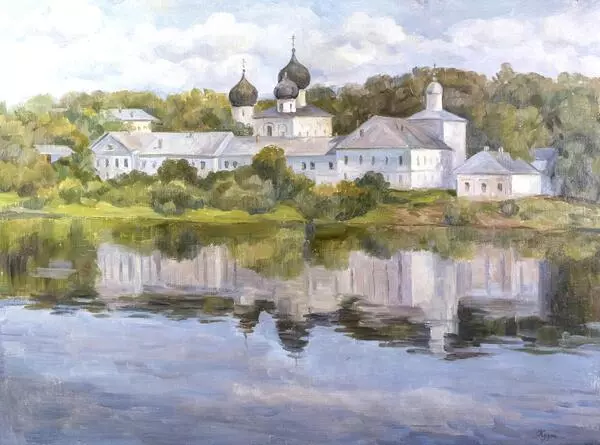Olga Alexandrovna Kuznetsova began to master artistic skills in Yaroslavl — first at a children’s art school, then at college. She was assigned a job by the state: she taught technical and artistic drawing at a school in the Perm region, after which she graduated as a specialist in interior and equipment design from the Vera Mukhina Leningrad Higher School of Art and Industry. Olga Alexandrovna’s further creative career as a designer and artist, her participation in art workshops and exhibitions, and her joining the Union of Designers and the Artists’ Union of Russia are connected with Veliky Novgorod. The artist created a number of monumental murals.
The monastery complex of the Zverin Intercession Monastery is located on the Sophia Side, behind the fortifications around the Novgorod Kremlin. On the bank of the Volkhov River, in ancient times there was a forest with a telling nickname — Zverinets (from the Russian “zver” — “beast, animal”), or Menagerie, after which the monastery was named. It was first mentioned in chronicles in 1069 as a game reserve for prices.
The exact date when the monastery was founded is unknown. For the first time it appears in chronicles of 1148, when “the thunder lit the Church of the Holy Mother of God.” The oldest known church of the monastery, the Church of the Intercession of the Theotokos, was rebuilt several times, but remained wooden: chroniclers mention the years of 1300 and 1335 (under Archbishop Vasily Kalik).
In 1399, Archbishop John II “with his children” — Novgorodians — erected and consecrated the first stone Intercession Church instead of the wooden one.
In 1467, a votive wooden church was constructed there in one day: during a severe epidemic in the Novgorod and Pskov lands, the people vowed to build it. A year later, a stone church of Simeon the God-Receiver was erected in its place. The 15th-century frescoes have been preserved on its walls.
After the Swedish invasion, according to the Inventory of 1617, the Intercession Church “collapsed to the ground”; the Church of Simeon the God-Receiver was rampaged. The rest of the monastery was also damaged. At that time, two elder nuns and four women who had not yet taken their monastic vows lived in it.
According to Archimandrite Makarii, in the 17th century, a dilapidated church of the Annunciation stood there; it has not survived to this day.
Between 1721 and 1727, the Zverin Monastery was assigned to the Syrkovo Monastery, then regained independence and accepted the nuns from the abolished Saint Nicholas (Nikolo-Belsky) Monastery. The bell tower of the abolished monastery was dismantled to build a bell tower in the Zverin Monastery above the stone gates.
In 1901, the ancient Intercession Church received a new name — it was consecrated in honor of the Tikhvin Icon of the Mother of God; the new large church, which operates to this day, is called the Intercession Cathedral.
The monastery complex of the Zverin Intercession Monastery is located on the Sophia Side, behind the fortifications around the Novgorod Kremlin. On the bank of the Volkhov River, in ancient times there was a forest with a telling nickname — Zverinets (from the Russian “zver” — “beast, animal”), or Menagerie, after which the monastery was named. It was first mentioned in chronicles in 1069 as a game reserve for prices.
The exact date when the monastery was founded is unknown. For the first time it appears in chronicles of 1148, when “the thunder lit the Church of the Holy Mother of God.” The oldest known church of the monastery, the Church of the Intercession of the Theotokos, was rebuilt several times, but remained wooden: chroniclers mention the years of 1300 and 1335 (under Archbishop Vasily Kalik).
In 1399, Archbishop John II “with his children” — Novgorodians — erected and consecrated the first stone Intercession Church instead of the wooden one.
In 1467, a votive wooden church was constructed there in one day: during a severe epidemic in the Novgorod and Pskov lands, the people vowed to build it. A year later, a stone church of Simeon the God-Receiver was erected in its place. The 15th-century frescoes have been preserved on its walls.
After the Swedish invasion, according to the Inventory of 1617, the Intercession Church “collapsed to the ground”; the Church of Simeon the God-Receiver was rampaged. The rest of the monastery was also damaged. At that time, two elder nuns and four women who had not yet taken their monastic vows lived in it.
According to Archimandrite Makarii, in the 17th century, a dilapidated church of the Annunciation stood there; it has not survived to this day.
Between 1721 and 1727, the Zverin Monastery was assigned to the Syrkovo Monastery, then regained independence and accepted the nuns from the abolished Saint Nicholas (Nikolo-Belsky) Monastery. The bell tower of the abolished monastery was dismantled to build a bell tower in the Zverin Monastery above the stone gates.
In 1901, the ancient Intercession Church received a new name — it was consecrated in honor of the Tikhvin Icon of the Mother of God; the new large church, which operates to this day, is called the Intercession Cathedral.








